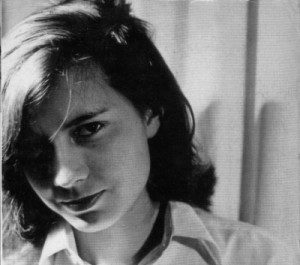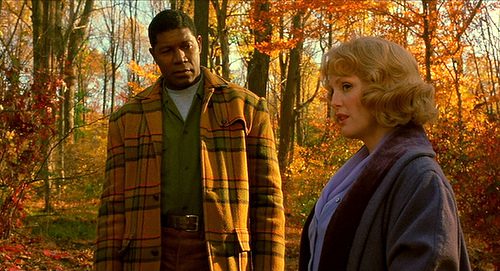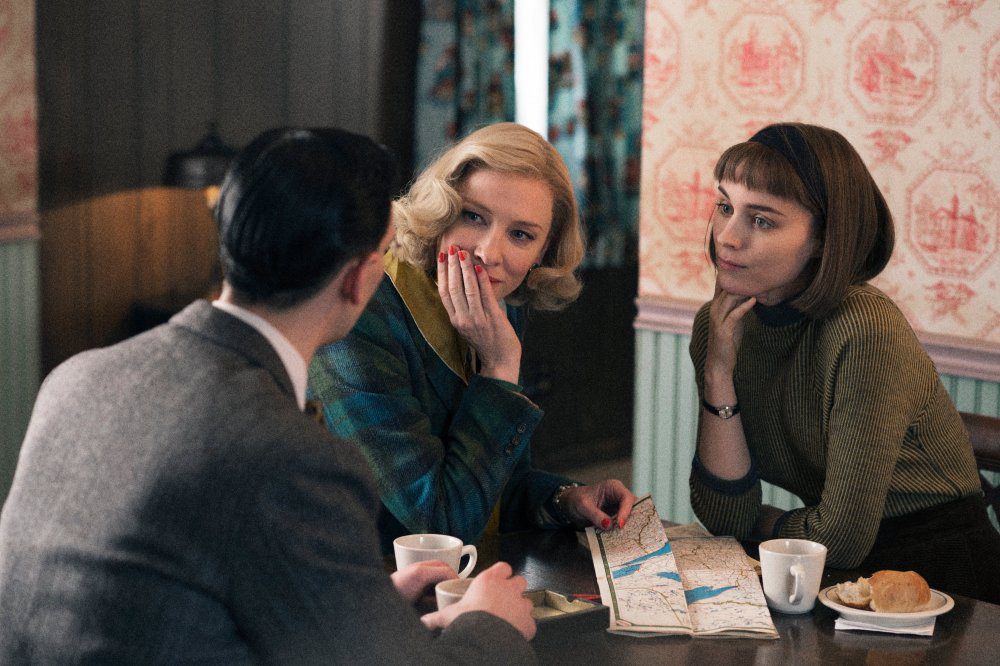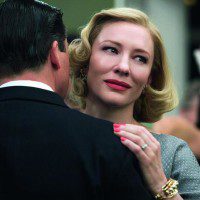In an early scene of Carol, lonely department store clerk Therese Belivet (Rooney Mara) begins her shift in the quiet darkness of a store soon mobbed by shoppers. The decorations are chintzy but warm: pale pink pastels surrounding antique baby dolls and a snowy model Christmas village, complete with a tiny train set. Therese is quiet, a “strange girl… flung out of space” as she will soon be called by her older female lover Carol Aird (Cate Blanchett), and she relishes the moment of silence. The film does too, taking in a close-up of the tiny village and the little train that will soon bring Therese and Carol together.
Carol is a romantic drama for sentimental hearts, with copious amounts of beautiful furnishings meant for the viewer’s longing stare. The film follows the illicit love affair between housewife Carol and amateur photographer Therese in the early 1950s, both women negotiating strict gender roles and the sharply defensive family rhetoric of the period. Carol is in the midst of divorcing her husband Harge (Kyle Chandler), and finds herself torn between the increasing danger she’ll lose custody of her children to a “morality clause” in the divorce agreement, and her blooming attraction to Therese. This all happens against the aesthetic backdrop of an idealized Christmastime, with trees, holiday lights, and warm coats figuring a lot of the romantic pull of the film. The title Carol is equal parts a referent to its protagonist and a reflection of the film’s holiday refrain, the film taking an iconography so often tied to normative families and repurposing it as a warmly queer christmas carol.
 Carol is the sixth feature film of director Todd Haynes, whose career also includes two widely respected short films and an HBO miniseries. Haynes has devoted many of his films to an American past of the 1950s: he displays an addiction to a loose genre I would describe as “midcentury melodrama.” These films mine an abstract 1950s United States past for its iconic value, often luxuriating in extensive costumes and set design, reflecting an image of undeniable glamor. Against this glamor the films depict immense cruelty along lines of gender, race, and sexuality, using extensive costume and design work to feel ultimately like a kind of weight: the characters bogged down and doomed by the repression necessitated by strict social authority. More often than not, these films play out in a melodramatic register, using sharp dramatizations of feeling as a reaction to all the silent sadness evoked in picture-perfect midcentury milieu. These film can stretch back to the 40s for subject matter and forward to the 60s; Mad Men certainly works in this same genre register.
Carol is the sixth feature film of director Todd Haynes, whose career also includes two widely respected short films and an HBO miniseries. Haynes has devoted many of his films to an American past of the 1950s: he displays an addiction to a loose genre I would describe as “midcentury melodrama.” These films mine an abstract 1950s United States past for its iconic value, often luxuriating in extensive costumes and set design, reflecting an image of undeniable glamor. Against this glamor the films depict immense cruelty along lines of gender, race, and sexuality, using extensive costume and design work to feel ultimately like a kind of weight: the characters bogged down and doomed by the repression necessitated by strict social authority. More often than not, these films play out in a melodramatic register, using sharp dramatizations of feeling as a reaction to all the silent sadness evoked in picture-perfect midcentury milieu. These film can stretch back to the 40s for subject matter and forward to the 60s; Mad Men certainly works in this same genre register.
I have long held an affinity for Haynes’s films and the interests they project, finding the sad beauty in an over-stylized past. As a queer cinephile a lot of my years of closeted self-loathing took shape in a secretive, fearful worshipping of LGBT movies and the desiring worlds they represented. One of my very favorites was The Talented Mr. Ripley (1999), more of a thriller than a melodrama, which follows a lonely social climber Tom Ripley (Matt Damon) and his dogged jealousy/attraction to a young socialite Dickie Greenleaf (Jude Law). Law has never looked more gorgeous than he does in Ripley, and the film works hard at perfecting a crackling homoerotic tension between the two men, one that feels all the more vulnerable as it’s shut down by one or both men in service of a supposed ethics of normal male behavior. Coincidentally, Ripley also features Cate Blanchett, deliciously threatening to tip the film towards camp as a broadly fabulous jet-setter. I would expect most queer people have these “closet archives” of material they watched under vulnerable circumstances, the films still projecting a unique aura of disruptive passion, even as we’ve become different, self-loving people.
 As an ironic twist of fate, both this sacred text of my own personal history and the subject of this review share the same writer as their founding imagination. Both The Talented Mr. Ripley and Carol were first written as novels by queer writer Patricia Highsmith, Carol as The Price of Salt under her pseudonym Claire Morgan in 1952, Ripley under her real name in 1955. Neither work could be easily queer in the restrictions of 1950s United States, the time placing a high premium on cultural works protecting and affirming “American values.” Highsmith’s openly lesbian couples were relegated to false names and low-culture pulp circles, while her gay couples hid in subtextual resonance in the mainstream, with the help of a thriller style that already suggested moral subversiveness. The clear queerness of her body of work feels like a defiant, heroic gesture today.
As an ironic twist of fate, both this sacred text of my own personal history and the subject of this review share the same writer as their founding imagination. Both The Talented Mr. Ripley and Carol were first written as novels by queer writer Patricia Highsmith, Carol as The Price of Salt under her pseudonym Claire Morgan in 1952, Ripley under her real name in 1955. Neither work could be easily queer in the restrictions of 1950s United States, the time placing a high premium on cultural works protecting and affirming “American values.” Highsmith’s openly lesbian couples were relegated to false names and low-culture pulp circles, while her gay couples hid in subtextual resonance in the mainstream, with the help of a thriller style that already suggested moral subversiveness. The clear queerness of her body of work feels like a defiant, heroic gesture today.
If Highsmith was being more literal in The Price of Salt than in her queer male fiction, it strikes me that Haynes seems to be on much of the same mission with his adaptation, sixty-three years after its first publication. Until Carol, Haynes’s examination of queer sexuality and fifties culture has been rooted in detached, postmodern explorations of the fifties. His first film Poison from 1991 is a composite of three different storylines, one a mocking pastiche of 1950s science fiction films like Them! and Invasion of the Body Snatchers, only as an allegory for the AIDS pandemic. His most critically lauded film until Carol, 2002’s Far From Heaven, is a top to bottom recreation of 1950s melodrama, complete with wildly expressive color and an expertly tearful leading lady (Julianne Moore). For all its thankful sincerity, Far From Heaven is still a quietly meta, postmodern experiment, focusing on an interracial relationship and resulting social persecution far more fully than any 50s film ever would have, as if suggesting “this is what a 50s film would have looked like if the world was a better, more loving place.” Haynes has related more to what we think about the 50s, and what visual culture the 1950s produced, than a lived reality of the time period. There are two partial exceptions: his glorious 1993 short film Dottie Gets Spanked, about a young boy’s fascination with an I Love Lucy-esque TV show, is mostly a no-frills cinema with the exception of some experimental dream sequences, and his 2011 HBO miniseries Mildred Pierce, which swings far into realism more to directly contrast with its famous Joan Crawford antecedent than anything else.
with an I Love Lucy-esque TV show, is mostly a no-frills cinema with the exception of some experimental dream sequences, and his 2011 HBO miniseries Mildred Pierce, which swings far into realism more to directly contrast with its famous Joan Crawford antecedent than anything else.
So, perhaps Carol is the fifties, for real this time. The film is still a midcentury melodrama, and widely glorifies a gorgeous production and costume design, but unlike Far From Heaven, Carol doesn’t foreground or emphasize a specific relationship to historical genre. Carol occupies a nervy, unsettled terrain in between the glamorous dream of the fifties and its messy, cruel outer reality. Haynes works this angle partly by having his central romance reflect a symbolic schematic of projected ideal and the eager audience. Cate Blanchett’s Carol is Far From Heaven incarnate, embodying a sublime beauty with every outfit, every look to the camera, every graceful wave of her hand. The Cannes Film Festival, where Carol premiered, affirmed the prodigious talents of Blanchett’s co-star Rooney Mara with the Best Actress award, and though I appreciate their choice to honor a less flashy performance, I continuously feel critics take Cate Blanchett’s regal majesty for granted. “Flashier” than Mara’s work perhaps, but Blanchett crafts each and every scene wondrously. Carol is a powerful woman with enviable self-knowledge, effortlessly creating an erotic, sensual ideal of herself as a covert spectacle for queer midcentury women. To watch this confidence stall and collapse with the tragic melodrama of the film is heartbreaking.
If Carol is the fifties spectacle of beauty, Therese is the spectator, looking through her camera and becoming changed and enlivened by the subject articulating her own queer desire. The quiet shyness of Therese, so afraid of finding a desiring life of her own, appeals to a broad illustration of glamor and prideful queer sensuality, experiencing love with another and coming closer to love herself in the process. She’s Todd Haynes, motivated so by fifties culture his career is dominated by it, and she’s also me, watching The Talented Mr. Ripley in secret.
Why does this pattern of spectacle have such a hold? I believe it’s the “midcentury melodrama” of it all, establishing the fifties as this sad, lonely, and already fictive zone, half-defined by reality, half-defined by what visual culture has made of the fifties, emphasizing emotion and queer desire as a possible chance for redemption. The harsh social repression of “the fifties” in the cinematic imagination is an exaggerated meme of all social authorities we continue to be subjected to, interrupted by the power of melodrama. And it’s all the more painful for how true the image reflected really is. Carol, with none of the postmodern genre furnishings of Haynes’s other work, demands attention to a slow, patient, actual reality.
of all social authorities we continue to be subjected to, interrupted by the power of melodrama. And it’s all the more painful for how true the image reflected really is. Carol, with none of the postmodern genre furnishings of Haynes’s other work, demands attention to a slow, patient, actual reality.
Perhaps this is why Carol’s sharpest, most memorable moments come in encounters with sensory awareness. The gentle way Carol strokes Therese’s back as she plays the piano. Therese holding Carol’s red gloves in her hands. A discrete touch of a shoulder in a busy restaurant. Carol’s quiet, minute intimacies emphasize a sensory reality that can’t be hemmed in by genre codes, that Haynes’s adoring camera captures in a low-key, lovely realism. Feeling immune to discrimination and social injustice. Feeling that transcends time and space.
***
Image credits: Featured image, image #2, image #3, image #4, image #5.




